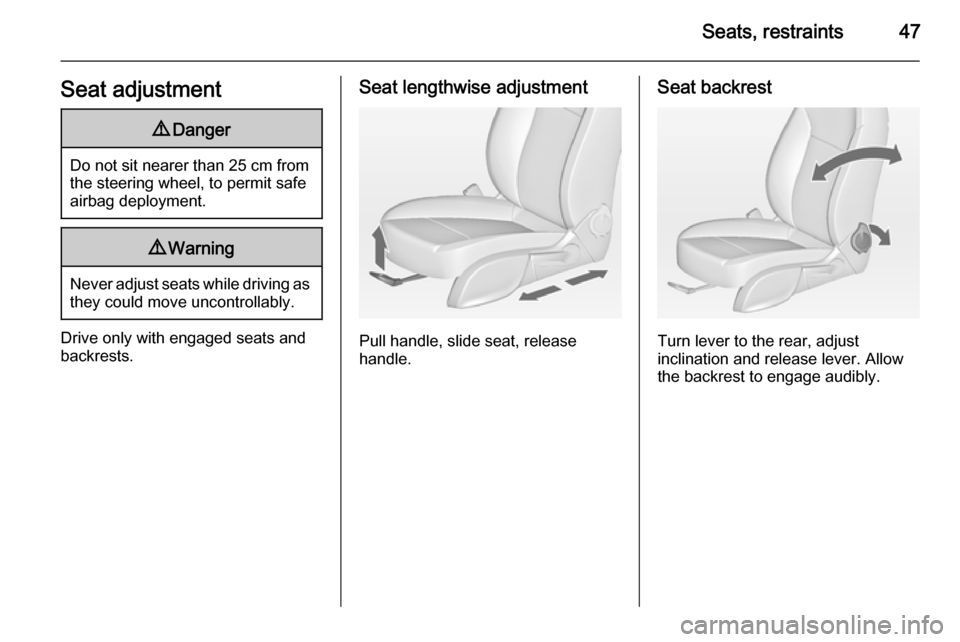seats OPEL CASCADA 2014 Owner's Manual
[x] Cancel search | Manufacturer: OPEL, Model Year: 2014, Model line: CASCADA, Model: OPEL CASCADA 2014Pages: 247, PDF Size: 7.45 MB
Page 3 of 247

Introduction.................................... 2
In brief ............................................ 6
Keys, doors and windows ............19
Seats, restraints ........................... 44
Storage ........................................ 68
Instruments and controls .............76
Lighting ...................................... 110
Climate control ........................... 123
Driving and operating .................133
Vehicle care ............................... 180
Service and maintenance ..........223
Technical data ........................... 226
Customer information ................238
Index .......................................... 240Contents
Page 19 of 247
![OPEL CASCADA 2014 Owners Manual In brief17
Automatic transmissionP=parkR=reverseN=neutralD=drive
Manual mode: move selector lever
from D to the left.
<=higher gear]=lower gear
The selector lever can only be moved
out of P when the OPEL CASCADA 2014 Owners Manual In brief17
Automatic transmissionP=parkR=reverseN=neutralD=drive
Manual mode: move selector lever
from D to the left.
<=higher gear]=lower gear
The selector lever can only be moved
out of P when the](/img/37/18792/w960_18792-18.png)
In brief17
Automatic transmissionP=parkR=reverseN=neutralD=drive
Manual mode: move selector lever
from D to the left.
<=higher gear]=lower gear
The selector lever can only be moved
out of P when the ignition is on and
the brake pedal is applied. To engage
P or R, press the release button.
Automatic transmission 3 141.
Starting off
Check before starting off ■ Tyre pressure and condition 3 203,
3 236.
■ Engine oil level and fluid levels 3 182.
■ All windows, mirrors, exterior lighting and number plates are free
from dirt, snow and ice and are
operational.
■ Proper position of mirrors, seats and seat belts 3 28, 3 46,
3 55.
■ Soft top must be completely opened or closed 3 34.
■ Brake function at low speed, particularly if the brakes are wet.Starting the engine
■ Turn key to position 1
■ move the steering wheel slightly to release the steering wheel lock
■ operate clutch and brake
■ automatic transmission in P or N
■ do not operate accelerator pedal
■ diesel engines: turn the key to position 2 for preheating and wait
until control indicator !
extinguishes
■ turn key to position 3 and release
Starting the engine 3 135.
Page 43 of 247

Keys, doors and windows41
There are two wind deflectors locatedin a bag behind the rear seat
backrests. Fold down the rear
backrests 3 71, open the Velcro
fasteners and move out the bag from
the recess.
■ The small wind deflector can be placed between the rear head
restraints.
■ The big wind deflector can be placed behind the front seats.
Do not place any objects on the wind
deflector.
To install the deflectors, the soft top
should be opened.
Fitting of the small wind
deflector ■ Fold down left rear backrest 3 71.
■ Remove the cover from the
guidance between the rear headrestraints by sliding sideways to the
left vehicle side.
■ Insert the adapter of the deflector with the elevation into the opposite
recess of the guidance.
■ Slide deflector in the guidance to the right vehicle side until it
engages.
■ Raise rear backrest.
Remove deflector in reverse order.
Fitting of the big wind deflector ■ Take the deflector out of the bag.
■ Extract the four locking pins of the deflector: the upper ones leap out
spring-loaded by turning the pins
Page 44 of 247

42Keys, doors and windows
out of the brackets on both sides,
the lower ones leap out by lifting the detents at the sliders on both sides.
■ Expand the wind deflector.
■ With the hinges behind the front seats insert the right side locking
pins in the recesses of the right side
trim near the rear seat. Fold the
deflector a little at the centre and
insert the left side locking pins in the
recesses of the left side trim. Make sure that all pins are properly
engaged. Push down the deflector
at the centre.
■ Fold up the upper part to vertical position.
The rear seats cannot be occupied
when the big wind deflector is
mounted.
The vertical part of the deflector can
be folded down when not used.
Wind deflector may remain mounted
when the soft top is closed.
For removing fold down vertical part
of the deflector. Lift up the deflector at
the centre a little and remove it from
the recesses on both sides.
Stowing the wind deflector
To stow the deflector, move in the rear locking pins by pushing back and turning the pins into the brackets.Push back the sliders of the front
locking pins until they engage. Swing
in the deflector and stow it in the bag.
Fold down the rear backrests. Align
the hard cover of the bag to the load
compartment. Position the bag from
the bottom up at the lateral guide in
the recess of the upper frame. Fix the
bag with the Velcro fastener at the
lashing eyes on both sides. Raise
rear backrests.
Page 46 of 247

44Seats, restraintsSeats, restraintsHead restraints............................ 44
Front seats ................................... 46
Seat belts ..................................... 53
Airbag system .............................. 56
Child restraints ............................. 62Head restraints
Position9 Warning
Only drive with the head restraint
set to the proper position.
The upper edge of the head restraint
should be at upper head level. If this
is not possible for extremely tall
people, set to highest position, and
set to lowest position for small people.
Adjustment
Head restraints on front seats
Height adjustment
Press release button, adjust height,
engage.
Page 47 of 247

Seats, restraints45
Horizontal adjustment
Pull bolster of head restraint forwardsslowly. It engages in several
positions.
To return to its rearmost position, pull
fully forwards and release.
Head restraints on rear seats
Height adjustment
Pull the head restraint upwards and
let engage. To move downwards, press the catch to release and push
the head restraint downwards.
Removal of rear head restraint
E.g. when using a child restraint
system 3 62.
Press both catches, pull the head
restraint upwards and remove.
Place the head restraint in a net bag
and secure the underside of the bag
with the Velcro fasteners on the load
compartment floor. A suitable net bag
is available at your workshop.
Active head restraints
In the event of a rear-end impact, the front parts of the active head
restraints are moved slightly
forwards. Thus the head is supported
so that the risk of whiplash injury is
reduced.
Page 48 of 247

46Seats, restraints
Note
Approved accessories may only be
attached if the seat is not in use.Front seats
Seat position9 Warning
Only drive with the seat correctly
adjusted.
■ Sit with buttocks as far back against
the backrest as possible. Adjust the distance between the seat and the
pedals so that legs are slightly
angled when pressing the pedals.
Slide the front passenger seat as
far back as possible.
■ Sit with shoulders as far back against the backrest as possible.
Set the backrest rake so that it is possible to easily reach the
steering wheel with arms slightly bent. Maintain contact between
shoulders and the backrest when
turning the steering wheel. Do not
angle the backrest too far back. We recommend a maximum rake of
approx. 25°.
■ Adjust the steering wheel 3 76.
■ Set seat height high enough to have a clear field of vision on allsides and of all display instruments.
There should be at least one hand
of clearance between head and the
roof frame. Your thighs should rest
lightly on the seat without pressing
into it.
■ Adjust the head restraint 3 44.
■ Adjust the thigh support so that there is a space approx. two fingers
wide between the edge of the seat
and the hollow of the knee.
■ Adjust the lumbar support so that it
supports the natural shape of the
spine.
Page 49 of 247

Seats, restraints47Seat adjustment9Danger
Do not sit nearer than 25 cm from
the steering wheel, to permit safe
airbag deployment.
9 Warning
Never adjust seats while driving as
they could move uncontrollably.
Drive only with engaged seats and
backrests.
Seat lengthwise adjustment
Pull handle, slide seat, release
handle.
Seat backrest
Turn lever to the rear, adjust
inclination and release lever. Allow
the backrest to engage audibly.
Page 50 of 247

48Seats, restraints
Seat height
Lever pumping motion
up=seat higherdown=seat lowerSeat inclination
Lever pumping motion
up=front end higherdown=front end lowerLumbar support
Adjust lumbar support using the four-way switch to suit personal
requirements.
Moving support up and down: push switch up or down.
Increasing and decreasing support:
push switch forwards or backwards.
Page 51 of 247

Seats, restraints49
Adjustable thigh support
Pull the lever and slide the thigh
support.
Seat folding
9 Warning
Passengers on rear seats should
take care not to be trapped by the
adjustment mechanism when the
seat moves back to its original
position.
Caution
When seat height is in highest
position, push head restraints
down and lift up sun visors before
folding backrest forwards.
Seat folding on manual
operated seats
Lift release lever and fold backrest
forwards, then slide seat forwards to
the stop.
To restore, slide the seat backwards
to the stop. Lift backrest to upright
position without operating any lever.
Ensure backrest engages.
When fully engaged the seat will be in
original position again.
Do not operate backrest inclination
lever while backrest is folded forward.
Seat folding on power seats
Lift release lever and fold backrest
forwards. The seat slides
automatically forwards to the stop.